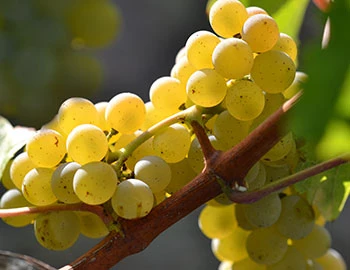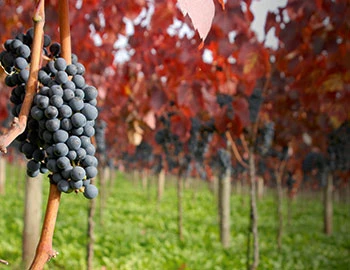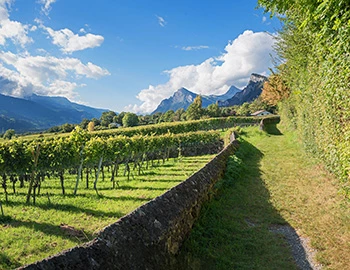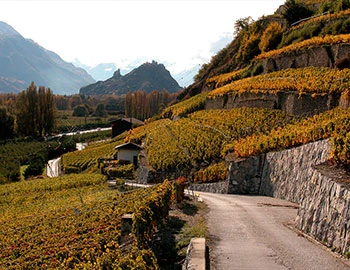3 BAR Sauvignon Blanc 2022
AOC Schaffhausen, Weingut zum Talheim, 750 ml

| Grape variety: | Sauvignon Blanc |
| Producer: | Hansruedi Adank |
| Origin: | Switzerland / Ostschweiz / Schaffhausen |
| Other bottle sizes: |
Description
The Confederates were three, as were the Musketeers, and three like-minded people joined forces for this wine: the Talheim winery in Schaffhausen, winemaker Hansruedi Adank from Graubünden and Baur au Lac Vins. A wine with many faces.
Aromas of grapefruit, gooseberry, lemon balm and elderflower enchant the nose. On the palate, the wine is lively and fruity, accompanied by a wonderful play of acidity. Tangy and expressive.
Our tip: with prawns with aioli, insalata caprese, crostini with goat's cheese and cress or simply tortilla chips with guacamole.
Attributes
| Origin: | Switzerland / Ostschweiz / Schaffhausen |
| Grape variety: | Sauvignon Blanc |
| Label: | Vegan |
| Ripening potential: | 1 to 4 years |
| Drinking temperature: | 10 to 12 °C |
| Food Pairing: | Fresh water fish with cream sauce, Asparagus specialities, Cheese board, Goat's cheese, Paella, Vegetable cous-cous |
| Vinification: | fully destemmed, short must fermentation |
| Harvest: | hand-picking |
| Maturation: | partly in steel tank, partly in barrique/ Pièces |
| Volume: | 13.5 % |
| Note: | Contains sulphites |
Sauvignon Blanc
The Sauvignon blanc can be recognized with your eyes closed. Its typical bouquet is marked by green notes: freshly cut grass, tomato bunches, gooseberry. Citrus fruits, cassis and flint join into the mix. In warmer latitudes it also shows exotic aromas, such as passion fruit. Its acidity is decidedly lively. In all likelihood, it comes from the Loire Valley, where it is vinified in Pouilly-Fumé and Sancerre in its purest form: varietally, and without timber. In the 18th century, it found its way to Bordeaux. Ambitious producers assemble it there with Sémillon into substantial whites, which are aged in oak barrels. The Sauvignon blanc has been a sensational success in the past 20 years in New Zealand. With its refreshing sweet-and-sour style, winemakers from down under have conquered the world. The rich Sauvignons from Styria and crisp examples of South Tyrol and Friuli are worth mentioning as well. It pairs with anything from the sea. Or do it like they do on the Loire, and enjoy it with goat cheese.

Schaffhausen
Schaffhausen: the elegance of the north
The northernmost vineyards in Switzerland are located in wine-growing villages such as Thayngen and Schleitheim. Nevertheless, the high quality Pinot Noir selections from here show an amazing richness and fruit. To express solidarity with this leading red variety, the wine-growing canton gained the name “Blauburgunderland.” The red variety occupies around 70 percent of the total cultivation area of 500 hectares, where it yields wines of astounding diversity.

Ostschweiz
Eastern Switzerland: an intriguing puzzle
Eastern Switzerland has long been positioned on the northern rim of the climate zone where the cultivation of popular Swiss varieties is possible. Due to a warming climate, the vineyards of Aargau, Zurich, Schaffhausen, Thurgau and Graubünden are now in the zone where varieties such as Müller-Thurgau or Pinot Noir succeed excellently. But even long-established, almost-forgotten varieties such as Elbling, Räuschling and Completer are experiencing a renaissance.

Switzerland
Switzerland – A small country with enormous diversity
Switzerland is famous for its banks, watches, and cheese, but not necessarily for its wine. The Swiss didn't invent wine, but they have been extremely open and curious to it. Wine culture arrived in what is now modern Switzerland via several routes: from Marseilles to Lake Geneva and the Lower Valais region; from the Aosta Valley through the Great St. Bernard Pass to the rest of Valais; from the Rhone through Burgundy, across the Jura Mountains to Lake Constance; and from Lombardy to Ticino, and then on to Grisons.



